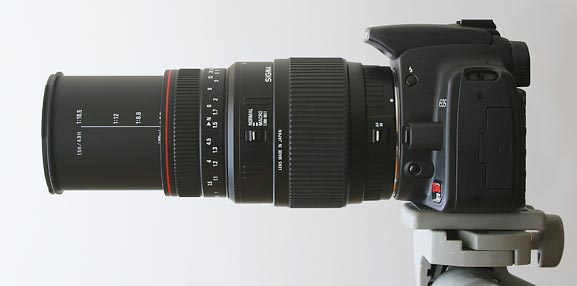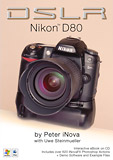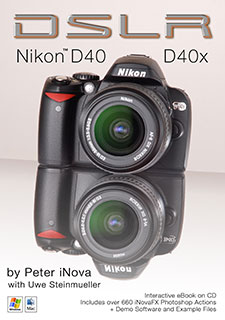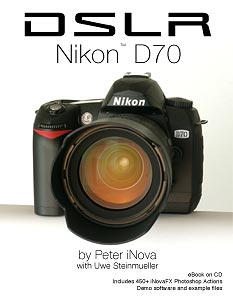
Your test results are revealing. When is a lens great? Is it the resolution, the handling, the build quality, the macro capability, the weight, the price? Or could it be some combination of all of these? Case in point: The Sigma 70-300mm APO Macro Super II zoom. Around $210-ish in toystores everywhere. Of course, if you're a working pro without any sense of mirth, that would be a Camera Shop where smiling is not allowed. Sorry, I seem to have drifted off... 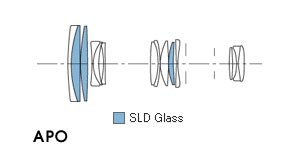 As we went into the 2005 Digital Shootout, Sigma USA sent us some lenses, the longest being their 70-300mm APO model, a revised version of a previous 70-300mm lens they've had for years. While we didn't have this earlier one in hand, it's obvious from the prescription of both lenses that the heritage here is solid. Rollover the diagram above and you see that the non-APO lens is virtually identical but with fewer SLD glass elements. As a study in design improvement, this gives us all an opportunity to peek within the exotic field of lens design and come away with new insights. Question #2: Are 35mm lenses good enough for digital? We shall see. Both lenses cover the same range. Both lenses have the same very close 1:2 macro ability at 300mm. A switch on the side of the lens selects a special 200-300mm macro range. Both lenses are the identical f-stops. Both are bargains. When an optical designer seeks to improve a tried and true lens prescription (just like your glasses, the formula even for a complex zoom is called a "prescription" by the folks who design them) the places they go looking first are areas in the image that seem to show and minor problems. What if the contrast started to drop off before coverage got close to the corner? What if chromatic aberrations got out of hand? What if focus at 20 feet was fine but infinity just didn't hook it? These are all realities designers balance, and as the design technologies grow in sophistication, so do the dreams of optical engineers. Special Low Dispersion glass (SLD) lets designers achieve tighter color focus, because wouldn't you know it, getting the reds, greens, blues, oranges, teals, yellows and purples all to line up is a never-ending hassle. If a color wanders in one element, the materials in another element has to steer it back in line. APO (not an acronym, it just is shorthand for apochromatic, meaning non color fringed) qualities promise better color registration and that can mean a lot when the extra enlargement factors of digital cameras start digging into the image.  So Sigma added two SLD elements to their 70-300 design, tweaked a few other elements and took the new design to the MTF machine. MTF, another TLA (Three Letter Acronym) stands for Modulation Transfer Function, a long established means of quantifying the sharpness of an optic by analyzing the contrast it passes when focused on a repetitious black/white/black/white... graphic pattern like the one above. A perfect lens would see such a figure as having 100% definition at all sizes, but nobody's perfect. 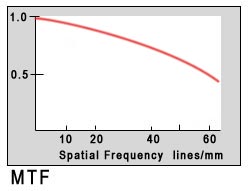 So the actual performance of a lens depends on how big the line pattern is and what percent of contrast makes it onto the image plane. In the case of film, the viewed performance must include the emulsion, processing and printing to be a number worth regarding, and with digital cameras, the absolute limit in resolution is two pixels next to each other, one getting a pure black image while the adjacent one sees a perfectly white one. In reality, at the optical center of the lens a higher result shows up and as the pattern shrinks, so does the lens's ability to see it clearly. A typical roll-off is shown above. If the lines of solid white and black fail utterly to show anything other than middle gray due to , that defines the zero point. So an MTF of 50% is really saying 50% of the tonal distance from middle gray to either black or white extreme. Lines per millimeter is a film idea. Digital sensors have pixels and recent DSLRs use sensors in the 7-6.4µm range, meaning micrometers or millionths of a meter. Each 7µm square pixel is 1/143rd of a millimeter which equates roughly to 72 lines/mm. The 350D's 6.4µm photosites do a bit better at 1/156th of a millimeter or around 78 lines/mm. Another way to look at it is this: Those little pixels are about 12-14 to the width of a human hair. To use this sort of info in evaluating a lens numerically, some standard of performance has to be established as a base line. Something like "We're talking 30 lines per millimeters here," and then the lens is read for its efficiency in reproducing that scale of pattern at the lens center, then farther off center. In a 35mm film camera the farthest off center is the corner of the frame at about 23mm. But for a DSLR such as the Canons and Nikons, the APS-C sensor is smaller than film by a substantial chunk, so the farthest off center we need to measure is only about 13.3mm. Well, you can forget that last 10mm, buddy, those results only apply to full frame use with this lens. So now we get to the consumer-educational part of our show. The MTF chart for the Sigma 70-300mm APO lens as published by Sigma: 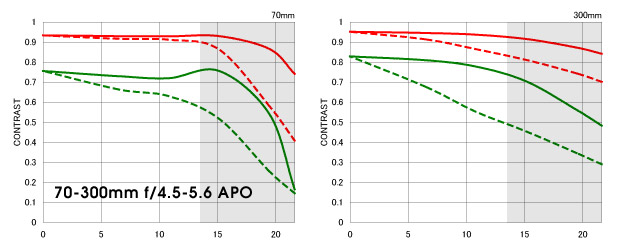 The criteria in lines per mm for these curves is 10 for the red lines and 30 for the green. They call out the center to corner distance in millimeters while revealing the full aperture results with solid lines showing how efficient the lens is with the pattern arranged radially (sagittally--aligned across the middle) and tangentially (meridionally--pointing perpendicular to a radius line). I've added a dark shading to block off the part of the chart that has no meaning to APS-C sized images. Just looking at these takes some interpretation. Overall, they're actually quite good, among the best you are likely to find in a sub-$1K zoom lens wide open. As the lens stops down from its widest aperture, these lines rise, crowding the top of the chart, so in this form, they're telling you a worst-case-scenario, and still, they're showing a very decent level of performance. Now for the fun part. Rollover the dual chart and you will see the performance characteristics of the 70-300mm lens that preceded the latest APO design. It's very close in performance to the APO version, dropping only slightly in the outer regions of the 70mm setting--at least as far as digital image coverage is concerned--and overall only about 5% in the 300mm end of the zoom. And here's the good news: That lens costs about $140US in toystores everywhere. Lunch for two for a few days! Howley Co! At that price, everybody should get one. From a resolution perspective, the area to the right of the grayed out zones are exceptionally good in resolution, and darned if those aren't exactly the areas covered by a typical APS-C -sized image chip. From a wallet perspective, a few percent of extra contrast in the corners of the image at wide open isn't worth $70 unless other performance factors are part of the mix. And to be fair, we don't have the full brace of MTF charts one needs to fully evaluate these optics, but we do see a trend. The newer, improved design certainly lives up to its name, but that older design, based on these MTF charts, is definitely not chopped liver. From a user perspective, this lens is fine, thanks, working close and distant without a worry in the world. Build quality is quite nice, zoom is easy, macro is lovely, focal range is suitably impressive (Nikon D70 and D50 owners will experience a 105-450mm effect while Canon 300D, 350D and 20D owners will feel it as a 112-480mm zoom), weight and size is just right and you cannot fume about the price of either variation. In all, this lens is either heading toward greatness or is already there. Here are some picks of pix. Rollover for 100% scale crop

 Both of the above were wide open during a Canon AI-Servo predictive auto-focus test. These frames were from mid-test, showing that the predictive AF was really quite good with this lens. The girl skater isn't in the best focus, but that whisp of hair may be. I think she just became aware of that guy way over there pointing his camera at her.
 This shows the best performance, and was made without whipping the camera around in candid capture, as in the first two shots. Focus, contrast and sharpness are now in cooperative agreement.  That last one was hand-held at 1/500 with maybe 2mm DOF. Look at the flower for corner performance under more steady conditions. Crops are 100%, showing pixels at actual size. If your display were 100 pixels per inch, these shots would be a yard wide. It even comes with its own deep lens hood. Canon makes a 70-300mm DO IS f/4.5-5.6 lens with killer image qualities and Image Stabilization. You can NOT beat the IS feature. It will let you shoot pictures other lenses can only dream about. Price? Ouch. Think $1200-ish. Later... -iNova
The eBooks Click to see the order page.
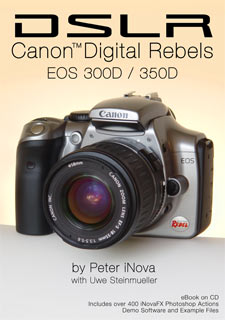 _ _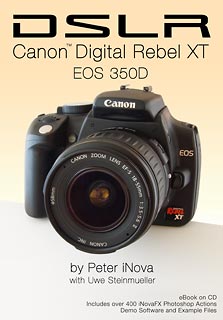 _ _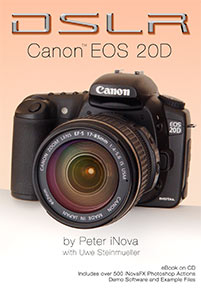 _ _
Photography and artwork on this site by Peter iNova. ©2005 Peter iNova, all rights reserved. |
||
